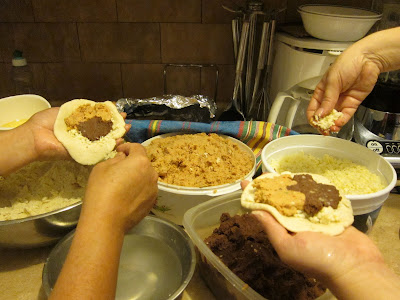This blog post is for Melissa. Melissa is one of my oldest friends (as in going back the farthest in my memory, not oldest in age). We met the second year of high school at our after school job in a library. We may have had everything in common then except our tastes in food. I have always been adventurous eater, even then. Melissa grew to be one later but in those days a hamburger with cheese was a little too exotic ( really, no cheese, no bun). I vaguely remember an issue with spaghetti sauce where Melissa reverted to noodles with ketchup.
Thankfully Melissa made it through that phase and so lessened the strain on our friendship (just kidding, Mel!). These days both of us have varied our eating habits largely based on our social, political and environmental views as they relate to the food industry. Melissa, although no longer shy about trying new flavors, is now a vegetarian. So this noodle-and-ketchup girl did not hesitate to dig in to my fontina polenta topped with sauteed ramps. Times certainly have changed.
In addition to vegetarianism being on the list of contributions to a new way of looking at diet, Melissa currently lives in Bujumbura, Burundi. We said goodbye in May before she moved and the question arose: "what will I eat?" There was not much way of knowing what to expect in terms of what types of food would be available and in two years she is bound to get homesick for some familiar flavors. Alas, no beloved broccoli in Burundi. What does Melissa do without her broccoli? "As soon as you get the chance send me a list of the foods that are most available and I will come up with recipes for them," I offered.
She has since assured me that she is eating alright although missing the occasional few comfort foods from home. Recently though, she sent me that list. so I will devote some blog posts to the challenge of cooking in Burundi...from New York.
Cut the top and bottom of pineapple off so that it is easier to cut off the spiny skin. Then you can take your knife and cut down along the side of the pineapple, removing the skin.
Pineapple Salsa
1 pineapple
2 serrano pepper (can substitute another hot pepper or chili)
2 scallions chopped fine
salt
3/4 cup chopped mint leaves (can substitute cilantro but you should probably use less)
Toss and refrigerate. This is better when the flavors get a chance to mingle. I would make this at least 2 hours in advance.
This is a great pairing with tortilla chips or fried plantains (easily found in Burundi, I believe).
We are the same in our thirties as we were in our teens.


























